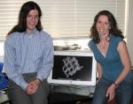(Press-News.org) (Santa Barbara, Calif.) –– Beginning around 542 million years ago, a profusion of animals with shells and skeletons began to appear in the fossil record. So many life forms appeared during this time that it is often referred to as the "Cambrian Explosion."
Geologists at UC Santa Barbara and a team of co-authors have proposed a rethinking of the timeline of these early animal appearances. Their findings are published in the latest issue of the Geological Society of America Bulletin.
Charles Darwin, in his book "On the Origin of Species," was troubled by the way the fossil record of this great proliferation of animals seemed to undermine his theory of evolution, and speculated that the pattern was due to the incompleteness of the geologic record.
"We found that with improved dating and correlation of rock sequences, the short burst of appearances goes away." said Susannah Porter, associate professor in the Department of Earth Science at UCSB. "Instead, appearances of the earliest skeleton-forming animals were drawn out over more than 20 million years."
UCSB graduate student John Moore added that skeletal animals became diverse much earlier than was thought, with nearly half of the animal genera in the dataset appearing in the first 10 million years of the Cambrian Period.
"The Cambrian diversification of animals was long thought to have begun with an explosive phase at the start of the Tommotian Stage, 17 million years above the base of the Cambrian," said Adam Maloof, first author and assistant professor of geosciences at Princeton University. "To test this idea, we matched earliest Cambrian records of carbon isotope variability from Siberia, Mongolia, and China with a Moroccan record constrained by five radiometric ages from interbedded volcanic ashes." This time interval was from 542-520 million years ago.
This approach avoids the circularity associated with using fossils to correlate rocks, and then using those correlations to infer biological patterns, explained Porter.
Porter said that, in addition to improving the timeline of early animal evolution, the team generated proxy records for sea level, carbon cycling, and the chemistry of oxidation-reduction in the ocean –– from the same sediments that contain the early animal fossils. The results indicate that early skeletal animals appeared during a 20-million-year interval of rising sea levels and increasingly oxidizing conditions at the sediment-water interface in shallow water environments.
INFORMATION:
Other researchers involved in the study include Frank Dudás, reseacher, and Samuel Bowring, professor, of the Massachusetts Institute of Technology; John Higgins, a postdoctoral fellow, and Michael Eddy, a senior, both at Princeton University; and David Fike, assistant professor at Washington University in St. Louis.
Funding for this work included a grant from the National Science Foundation.
New time line for appearances of skeletal animals in fossil record developed by UCSB researchers
2010-11-11
ELSE PRESS RELEASES FROM THIS DATE:
Novel metamaterial vastly improves quality of ultrasound imaging
2010-11-11
University of California, Berkeley, scientists have found a way to overcome one of the main limitations of ultrasound imaging – the poor resolution of the picture.
Everyone who has had an ultrasound, including most pregnant women, is familiar with the impressionistic nature of the images. One of the limits to the detail obtainable with sonography is the frequency of the sound: The basic laws of physics dictate that the smallest objects you can "see" are about the size of the wavelength of the sound waves. For ultrasound of deep tissues in the body, for example, the sound ...
Study finds low birth weight may cause lifelong problems processing medications
2010-11-11
CORVALLIS, Ore. – New research has found that a mother's poor nutrition during pregnancy and nursing can cause problems for her offspring's ability to process medications, even well into adulthood.
The results of the study, by Oregon State University researchers, suggest that in the future physicians prescribing drugs ranging from Tylenol to cancer chemotherapies may need to factor birth weight along with body weight into dosing decisions for their patients.
In this laboratory study, the kidneys of underweight animals born to mothers fed low-protein diets during pregnancy ...
A love game: Fish courtship more complex than thought
2010-11-11
Monash University researchers have discovered that male Australian desert goby fish are surprisingly strategic when it comes to courtship, adapting their tactics depending on the frequency of their contact with females.
Attracting females involves significant time, energy and exposure to predation and previous research has indicated that male gobies are more likely to court larger females due to the number of eggs they carry compared with their smaller counterparts.
However, new research, published in the journal Behavioral Ecology and Sociobiology, indicates that ...
Mid-life cholesterol levels not linked to Alzheimer's disease
2010-11-11
ST. PAUL, Minn. – Contrary to earlier research, a new, long-term study suggests that cholesterol level in mid-life may not be linked to later development of Alzheimer's disease, according to a study published in the November 10, 2010, online issue of Neurology®, the medical journal of the American Academy of Neurology. However, the results suggest that large decreases in cholesterol levels in old age could be a better predictor of developing the memory-robbing disease.
"While some studies suggest that cholesterol is a risk factor for dementia, others have not replicated ...
High cholesterol in middle age women not a risk factor for Alzheimer's and other dementias
2010-11-11
High cholesterol levels in middle age do not appear to increase women's risk of developing Alzheimer's disease and other forms of dementia later in life, new Johns Hopkins-led research finds, despite a body of scientific evidence long suggesting a link between the two.
What the study, published online in the journal Neurology, does find is that women whose cholesterol levels decline from middle age to old age are at 2.5 times greater risk of developing the memory-wasting diseases than those whose cholesterol stayed the same or increased over the years.
"Our research ...
Fructose-rich beverages associated with increased risk of gout in women
2010-11-11
Consumption of fructose-rich beverages, such as sugar-sweetened sodas and orange juice is associated with an increased risk of gout among women, although their contribution to the risk of gout in the population is likely modest because of the low incidence rate among women, according to a study that will appear in the November 24 print edition of JAMA. The study is being released early online to coincide with its presentation at the American College of Rheumatology annual scientific meeting.
Gout is a common and very painful inflammatory arthritis. "The increasing disease ...
Atoms-for-Peace: A galactic collision in action
2010-11-11
Atoms-for-Peace is the curious name given to a pair of interacting and merging galaxies that lie around 220 million light-years away in the constellation of Aquarius. It is also known as NGC 7252 and Arp 226 and is just bright enough to be seen by amateur astronomers as a very faint small fuzzy blob. This very deep image was produced by ESO's Wide Field Imager on the MPG/ESO 2.2-metre telescope at ESO's La Silla Observatory in Chile.
A galaxy collision is one of the most important processes influencing how our Universe evolves, and studying them reveals important clues ...
Scientists launch global scheme to boost rice yields while reducing damage to environment
2010-11-11
Hanoi, Vietnam (November 10, 2010)—One of the world's largest global scientific partnerships for sustainable agricultural development has launched a bold new research initiative that aims to dramatically improve the ability of rice farmers to feed growing populations in some of the world's poorest nations. The efforts of the Global Rice Science Partnership, or GRiSP, are expected to lift 150 million people out of poverty by 2035 and prevent the emission of greenhouse gases by an amount equivalent to more than 1 billion tons of carbon dioxide.
An initiative of the Consultative ...
Romiplostim more effective than standard care for immune thrombocytopenia
2010-11-11
A new study finds that an FDA-approved drug to treat the rare autoimmune disorder immune thromobocytopenia (ITP) is more effective than earlier medical therapies in helping patients avoid surgical treatment and significantly improving their quality of life. The paper in the Nov. 11 New England Journal of Medicine reports that treatment with romiplostim, which mimics the effects of a growth factor that regulates platelet production, was more than three times more successful than standard therapy with steroids or immunosuppressive drugs.
"This is the first definitive ...
Inhibitory neurons key to understanding neuropsychiatric disorders
2010-11-11
HOUSTON -- (Nov. 11, 2010) – The brain works because 100 billion of its special nerve cells called neurons regulate trillions of connections that carry and process information. The behavior of each neuron is precisely determined by the proper function of many genes.
In 1999, Baylor College of Medicine (www.bcm.edu) researcher Dr. Huda Zoghbi (http://www.bcm.edu/genetics/index.cfm?pmid=11053), and her colleagues identified mutations in one of these genes called MECP2 as the culprit in a devastating neurological disorder called Rett syndrome (http://www.nichd.nih.gov/health/topics/rett_syndrome.cfm). ...


